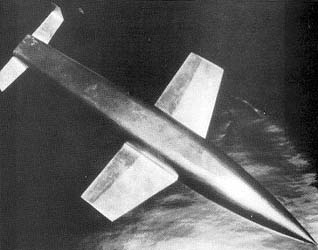Silverbird
|
|
Silverbird is also the name of a Telecomsoft software label.
Silbervogel, German for Silverbird, was a design for a rocket-powered sub-orbital bomber aircraft produced by Eugen Sänger and Irene Bredt in the late 1930s. It is sometimes referred to as the Amerika Bomber, although it was only one of a number of designs considered for this mission. When Walter Dornberger attempted to create interest in military spaceplanes in the United States after World War II, he chose the more diplomatic term antipodal bomber. The design was a significant one, as it incorporated new rocket technology, and the principle of the lifting body. In the end, it was considered too complex and expensive to produce. The design never went beyond wind tunnel testing (pictured).
The Silverbird was intended to fly long distances in a series of short hops. The aircraft was to have begun its mission propelled along a 3 km (2 miles) long monorail track by a large rocket-powered sled. Once airborne, it was to fire its own rocket engine and continue to climb to an altitude of 145 km (90 miles), at which point it would be travelling at some 22,100 km/h (13,800 mph). It would then gradually descend into the stratosphere, where the increasing air density would generate lift against the flat underside of the aircraft, eventually causing it to "bounce" and gain altitude again, where this pattern would be repeated. Because of drag, each bounce would be shallower than the preceding one, but it was still calculated that the Silbervogel would be able to cross the Atlantic, deliver a 4,000 kg (8,800 lb) bomb to the continental US, and then continue its flight to a landing site somewhere in the Japanese held Pacific, a total journey of 24,000 km (15,000 miles).
Post-war analysis of the Silverbird design turned up a mistake in the calculation of aerodynamic heating during re-entry. Correcting the mistake leads to the unmistakable conclusion that the Silbervogel would have burned up on re-entry. Nevertheless the problem was not impossible to fix, and following World War II, both the US and the USSR showed an interest in Sänger's work.
In the Soviet Union, Stalin became fascinated with the concept and attempted to have Sänger kidnapped and taken to the USSR to continue work on the design. When this plan failed a new design bureau was set up by Mstislav Vsevolodovich Keldysh in 1946 to research the idea. A new version powered by ramjets instead of a rocket engine was developed, generally known as the Keldysh Bomber, but not produced. The design formed the basis for a number of additional cruise missile designs right into the early 1960s, but none of these were produced either.
Sänger was tipped off to the original kidnapping attempt by French agents, and decided to follow the many other German engineers to the United States. In the US, the project eventually gave rise to the abortive X-20 Dyna-Soar, a direct development of the Silbervogel to be launched on a Titan II booster. As the manned space role moved to NASA and the unmanned reconnaissance satellites were thought to be capable of all reasonable missions, the Air Force gradually withdrew from manned space flight and the Dyna-Soar was cancelled.
One lasting piece of the Silverbird design was the "regenerative engine" design, in which fuel or oxidizer is run in tubes around the engine bell in order to both cool the bell and pressurize the fluid. Almost all modern rocket engines use this design today. Some sources still refer to this concept as the Sänger-Bredt design.
|
Lists of Aircraft | Aircraft manufacturers | Aircraft engines | Aircraft engine manufacturers Airports | Airlines | Air forces | Aircraft weapons | Missiles | Timeline of aviation |

